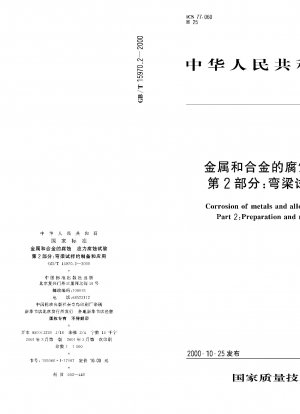GB/T 15970.2-2000
Corrosion of metals and alloys-Stress corrosion testing--Part 2: Preparation and use of bent-beam specimens (English Version)
- Standard No.
- GB/T 15970.2-2000
- Language
- Chinese, Available in English version
- Release Date
- 2000
- Published By
- General Administration of Quality Supervision, Inspection and Quarantine of the People‘s Republic of China
- Latest
- GB/T 15970.2-2000
- Scope
- This part of GB/T 15970 deals with the design, preparation and use procedures of bent beam specimens for the study of the susceptibility of metals to stress corrosion. The term "metal" used in this part of GB/T 15970 includes alloys. Bending beam specimens can be used to test various forms of products. Primarily suitable for rolled strip, plate or tube, whereby sheet specimens with a rectangular cross-section are conveniently available, but also for cast material, wire, rod or machined specimens with a circular cross-section. Bent beam specimens can also be applied to welded components. The preparation of the sample and the loading device are simple and cheap. Therefore, the bent beam sample is especially suitable for a large number of tests and atmospheric stress corrosion tests. Bending beam specimens are generally tested under nominal constant strain conditions, but nominal constant load conditions can also be used. In both cases, a local change in the curvature of the specimen when cracking occurs will result in a change in the crack growth conditions. "Test stress" shall be taken as the highest surface tension stress at the beginning of the test.
GB/T 15970.2-2000 history
- 2000 GB/T 15970.2-2000 Corrosion of metals and alloys-Stress corrosion testing--Part 2: Preparation and use of bent-beam specimens

GB/T 15970.2-2000 -All Parts
GB/T 15970.1-2018 Corrosion of metals and alloys.Stress corrosion testing.Part 1:General guidance on testing procedures
GB/T 15970.10-2021 Corrosion of metals and alloys—Stress corrosion testing—Part l0: Reverse U-bend method
GB/T 15970.11-2022 Corrosion of metals and alloys—Stress corrosion cracking—Part 11: Guidelines for testing the resistance of metals and alloys to hydrogen embrittlement and hydrogen-assisted cracking
GB/T 15970.2-2000 Corrosion of metals and alloys-Stress corrosion testing--Part 2: Preparation and use of bent-beam specimens
GB/T 15970.3-1995 Corrosion of metals and alloys--Stress corrosion testing--Part 3: Preparation and use of U--bend specimens
GB/T 15970.4-2000 Corrosion of metals and alloys-Stress corrosion testing--Part 4: Preparation and use of uniaxially loaded tension specimens
GB/T 15970.5-1998 Corrosion of metals and alloy--Stress corrosion testing--Part 5: Preparation and use of C-ring specimens
GB/T 15970.6-2007 Corrosion of metals and alloys.Stress corrosion testing.Part 6: Preparation and use of pre-cracked specimens for tests under constant load or constant displacement
GB/T 15970.7-2017 Corrosion of metals and alloys—Stress corrosion testing—Part 7: Slow strain rate testing
GB/T 15970.8-2005 Corrosion of metals and alloys.Stress corrosion test.Part 8:Preparation and use of specimens to evaluate weldments
GB/T 15970.9-2007 Corrosion of metals and alloys.Stress corrosion testing.Part 9: Preparation and use of pre-cracked specimens for tests under rising load or rising displacement